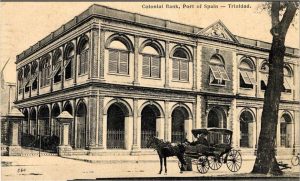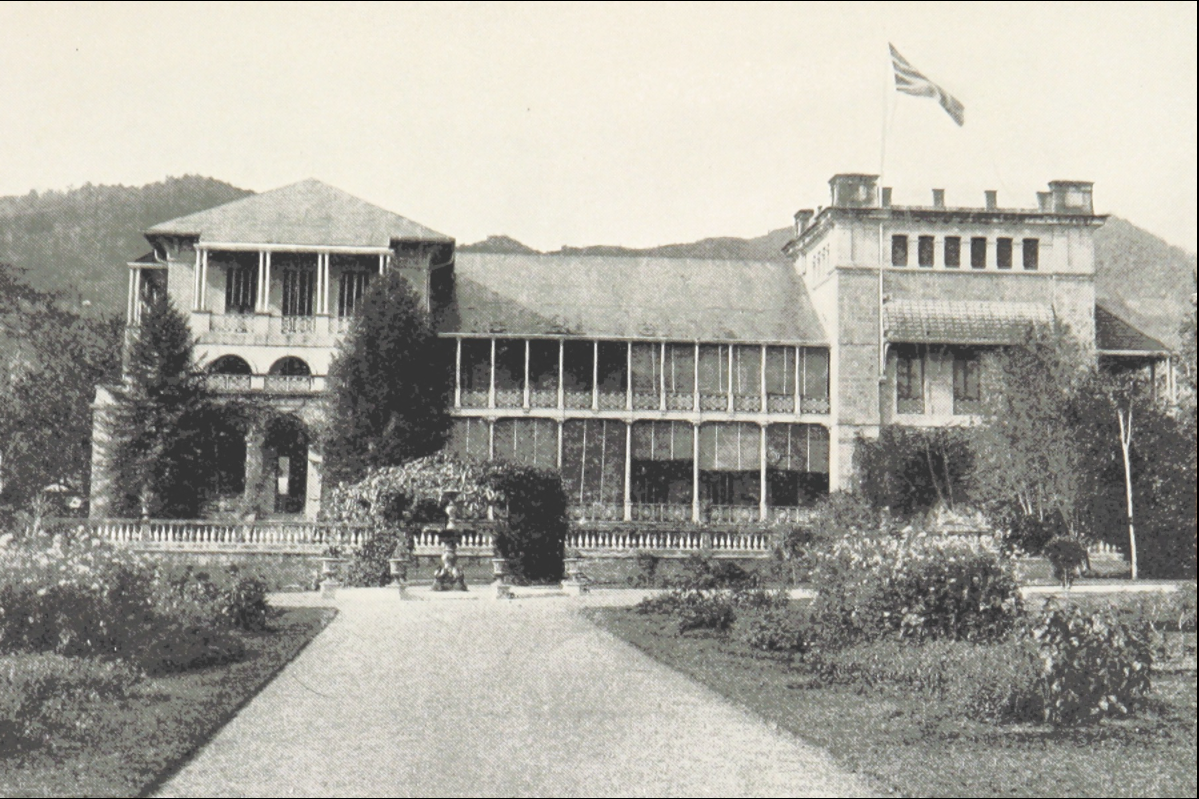101
Trinidad 19th Apl 1894
My dear Mother,
To-morrow I go on to Curaçao. Just sent off six letters by this mail & now I come to yours, which must be short.

Business has been dull here & so have I. Last night I had a very good game of whist, & the night before some chess – not so good. To-night I dine out, – with a man called Twose, in the Colonial Bank, a nice fellow with whom I have spent most of my leisure hours here. He has asked Henry Tate to meet me, one of the long family that used to live at Queen’s Elms.[1] He is now Govmt. Analyst in Trinidad. I have not met him yet, but I think he was a “small boy” at the Inst. when I was there.[2]
These West India Islands are very beautiful. At the back of Port of Spain there is an amphitheatre of low hills, covered with palms, & mangos, bread-fruit trees, acacias, banyans, cocoa-trees, – the usual tropical vegetation. Right at the foot of them is Government House, a fine residence, with the Botanical Gardens. In front of them the magnificent Savannah stretches out, two & a quarter miles round, & between it & the sea is the town.[3]
The Savannah is the public park & play-ground. In the afternoons you may see cricket, golf, polo, kite-flying without end, & other sports going on, & several pretty girls with their attendant swains having a fine canter on horseback over the green turf.[4]

Coming from Barbados our steamer called at the pretty little islands of St. Vincent & Grenada.[5] At the latter place I went ashore & took a walk round the hills at the back of the town. A three-feet-of-ebony offered his services as guide for a penny. I asked him if he knew of a school master called Chitty, a man I used to know in Barbados. He thought the gentleman was at the Grammar School. I asked my guide if he went there. “Oh no, Sah, only white people’s childrens goes there”. He told me that the Governor’s Lady was pretty, & she had a daughter as big as herself, & “when they drives out to-gether you’ll think its sisters”. No courtier could have paid the Governor’s Lady a prettier compliment. We found our way to the Botanical Gardens where there were a dozen convicts trimming the flower beds, – a pleasanter occupation than breaking stones. On the top of the hill was the dismal prison. I asked my guide if people ever did anything wrong in such a lovely little island, so as to get locked up. “Oh yes, Sah.” & after a time, as if proud of Grenada being up to date “they sometimes kills people.”
In the town I was amused at the frank directness of the public-house signboards, “Licensed to sell intoxicating liquors.”
The greatest drawback to one’s appreciation of the surroundings in all these places is the omnipresent “corbo”, or big, repulsive carrion crow, the town scavenger, which it is forbidden to molest under a heavy penalty.[6]
Now, Misses, time’s up & I must trot off to post with this.
Best love
Jack
- Henry Tate (born 2nd February 1867 [youngest of 13 children], d 18th August 1894). He died aged 27 just 4 months after JMcC met him in Trinidad. From Belfast Newsletter of the 8th September 1894 – Death notices: “TATE – August 18, at Trinidad, of malignant fever. Henry, Assistant Government Analyst, youngest son of Alexander Tate, Longwood, Belfast." Henry's father Alexander Tate (b 1st July 1823 in Barnes, Surrey, d 29th July 1904 Rantalard, Whitehouse) had married his Belfast mother Margaretta Creery (b 9th September 1826 Ireland, d 21st June 1911 in Whitehouse, Antrim) on 16th July 1846 in Kilcoo Co Down. At the time of his death, was noted as being the 'father" of the Institution of Civil Engineers of Ireland (which he had joined in 1844): https://www.dia.ie/architects/view/5265/tate-alexander ↵
- "the Inst": The Royal Belfast Academical Institution is an independent grammar school in Belfast, Northern Ireland. With the support of Belfast's leading reformers, it opened its doors in 1814. Locally referred to as Inst, the modern school educates boys from ages 11 to 18: https://en.wikipedia.org/wiki/Royal_Belfast_Academical_Institution. JMcC attended this school and was associated with it all his life. ↵
- Queen’s Park Savannah. Known locally as simply "the Savannah," it is Port of Spain's largest open space: https://en.wikipedia.org/wiki/Queen%27s_Park_Savannah ↵
- A "swain" is a male admirer or suitor. ↵
- Grenada may be pretty but is has a dismal colonial history: https://en.wikipedia.org/wiki/History_of_Grenada ↵
- A Grenadian Black Crow: https://www.pinterest.com.au/pin/65935582017939564/ ↵
